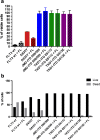Internal tandem duplication mutations in the tyrosine kinase domain of FLT3 display a higher oncogenic potential than the activation loop D835Y mutation
- PMID: 29372308
- PMCID: PMC5876274
- DOI: 10.1007/s00277-018-3245-5
Internal tandem duplication mutations in the tyrosine kinase domain of FLT3 display a higher oncogenic potential than the activation loop D835Y mutation
Abstract
Acute myeloid leukemia (AML) remains the most common form of acute leukemia among adults and accounts for a large number of leukemia-related deaths. Mutations in FMS-like tyrosine kinase 3 (FLT3) is one of the most prevalent findings in this heterogeneous disease. The major types of mutations in FLT3 can be categorized as internal tandem duplications (ITD) and point mutations. Recent studies suggest that ITDs not only occur in the juxtamembrane region as originally described, but also in the kinase domain. Although the juxtamembrane ITDs have been well characterized, the tyrosine kinase domain ITDs have not yet been thoroughly studied due to their recent discovery. For this reason, we compared ITD mutations in the juxtamembrane domain with those in the tyrosine kinase domain, as well as with the most common activating point mutation in the tyrosine kinase domain, D835Y. The purpose of this study was to understand whether it is the nature of the mutation or the location of the mutation that plays the main role in leukemogenesis. The various FLT3 mutants were expressed in the murine pro-B cell line Ba/F3 and examined for their capacity to form colonies in semisolid medium. The size and number of colonies formed by Ba/F3 cells expressing either the internal tandem duplication within juxtamembrane domain of the receptor (JMD-ITD) or the tyrosine kinase domain (TKD)-ITD were indistinguishable, while Ba/F3 cells expressing D835Y/FLT3 failed to form colonies. Cell proliferation and cell survival was also significantly higher in TKD-ITD expressing cells, compared to cells expressing D835Y/FLT3. Furthermore, TKD-ITD is capable of inducing phosphorylation of STAT5, while D835Y/FLT3 fails to induce tyrosine phosphorylation of STAT5. Other signal transduction pathways such as the RAS/ERK and the PI3K/AKT pathways were activated to the same level in TKD-ITD cells as compared to D835Y/FLT3 expressing cells. Taken together, our data suggest that TKD-ITD displays similar oncogenic potential to the JMD-ITD but a higher oncogenic potential than the D835Y point mutation.
Keywords: Acute myeloid leukemia; FLT3; ITD; Internal tandem duplication; Receptor tyrosine kinase.
Conflict of interest statement
The authors declare that they have no conflict of interest.
Figures




Similar articles
-
FLT3-ITD and tyrosine kinase domain mutants induce 2 distinct phenotypes in a murine bone marrow transplantation model.Blood. 2005 Jun 15;105(12):4792-9. doi: 10.1182/blood-2004-11-4430. Epub 2005 Feb 17. Blood. 2005. PMID: 15718420
-
AML-associated Flt3 kinase domain mutations show signal transduction differences compared with Flt3 ITD mutations.Blood. 2005 Jul 1;106(1):265-73. doi: 10.1182/blood-2004-07-2942. Epub 2005 Mar 15. Blood. 2005. PMID: 15769897
-
Activating FLT3 mutants show distinct gain-of-function phenotypes in vitro and a characteristic signaling pathway profile associated with prognosis in acute myeloid leukemia.PLoS One. 2014 Mar 7;9(3):e89560. doi: 10.1371/journal.pone.0089560. eCollection 2014. PLoS One. 2014. PMID: 24608088 Free PMC article.
-
[FLT3 Mutations in Acute Myeloid Leukemia].Rinsho Byori. 2017 Jan;65(1):44-51. Rinsho Byori. 2017. PMID: 30695511 Review. Japanese.
-
Targeting Oncogenic Signaling in Mutant FLT3 Acute Myeloid Leukemia: The Path to Least Resistance.Int J Mol Sci. 2018 Oct 16;19(10):3198. doi: 10.3390/ijms19103198. Int J Mol Sci. 2018. PMID: 30332834 Free PMC article. Review.
Cited by
-
How ITD Insertion Sites Orchestrate the Biology and Disease of FLT3-ITD-Mutated Acute Myeloid Leukemia.Cancers (Basel). 2023 May 30;15(11):2991. doi: 10.3390/cancers15112991. Cancers (Basel). 2023. PMID: 37296951 Free PMC article. Review.
-
Profiling FLT3 Mutations in Mexican Acute Myeloid Leukemia Pediatric Patients: Impact on Overall Survival.Front Pediatr. 2020 Sep 16;8:586. doi: 10.3389/fped.2020.00586. eCollection 2020. Front Pediatr. 2020. PMID: 33042924 Free PMC article.
-
Decoding the anti-cancer potential of Pexidartinib (PLX3397), a Fms-like tyrosine kinase 3 inhibitor, using next-generation knowledge discovery methods.Bioinformation. 2024 May 31;20(5):460-472. doi: 10.6026/973206300200460. eCollection 2024. Bioinformation. 2024. PMID: 39132250 Free PMC article.
-
Association between increased mutation rates in DNMT3A and FLT3-ITD and poor prognosis of patients with acute myeloid leukemia.Exp Ther Med. 2019 Oct;18(4):3117-3124. doi: 10.3892/etm.2019.7891. Epub 2019 Aug 14. Exp Ther Med. 2019. PMID: 31572552 Free PMC article.
-
[Effect of endoplasmic reticulum stress induced by all-trans retinoic acid on apoptosis of FLT3-ITD mutated leukemia cells by activating autophagy in FLT3-ITD mutated protein].Zhonghua Xue Ye Xue Za Zhi. 2020 Oct 14;41(10):836-842. doi: 10.3760/cma.j.issn.0253-2727.2020.10.008. Zhonghua Xue Ye Xue Za Zhi. 2020. PMID: 33190441 Free PMC article. Chinese.
References
-
- Nakao M, Yokota S, Iwai T, Kaneko H, Horiike S, Kashima K, Sonoda Y, Fujimoto T, Misawa S. Internal tandem duplication of the flt3 gene found in acute myeloid leukemia. Leukemia. 1996;10(12):1911–1918. - PubMed
-
- Breitenbuecher F, Schnittger S, Grundler R, Markova B, Carius B, Brecht A, Duyster J, Haferlach T, Huber C, Fischer T. Identification of a novel type of ITD mutations located in nonjuxtamembrane domains of the FLT3 tyrosine kinase receptor. Blood. 2009;113(17):4074–4077. doi: 10.1182/blood-2007-11-125476. - DOI - PubMed
MeSH terms
Substances
Grants and funding
LinkOut - more resources
Full Text Sources
Other Literature Sources
Miscellaneous

